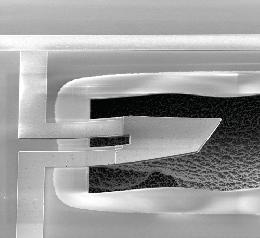... or at least it should. It blew mine back when I read it. Here is an article from Nature documenting a research effort in quantum mechanics. The research that this article discusses shows that even large objects can exhibit the weird quantum effects I've been talking about. I recommend reading the article, even though I'm not entirely pleased with some of the terminology (quantum mechanics is a tricky subject, and requires precise words to describe it.). If you're feeling lazy at the moment, my summary is below.
Andrew Cleland and his team of researchers at UCSB successfully measured an object large enough to be see with the "naked eye" exhibiting one of the most strange and difficult to swallow aspects of quantum mechanics. A quantum object can be in a state where it's moving, and a state where it's not - at the SAME time! These scientists were able to measure this in a tiny paddle that is 30 micrometers (that's about one thousandth of an inch!) in length. Here's a picture below:
This object is huge, at least in quantum terms. It's built out of trillions of atoms! What they observed is the object being simultaneously in a vibrating and stationary state at the same time! They did this by cooling the drum to 2 tenths of a degree Fahrenheit above the lowest possible temperature (absolute zero). This brought the molecules in the drum to their very lowest energy state. They were able to verify that it was not vibrating at all. With a quantum mechanical circuit, they could also bump up the energy level to make the drum vibrate at a VERY specific energy level. They put their circuit into what's called a quantum superposition state (a quantum state that is actually a mixture of two states, e.g. moving and not moving). The circuit was a superposition of telling the drum to be stationary, and to vibrate. What was the result? Exactly that! They were able to measure the drum as vibrating and not vibrating at the same time!
Let's review for a second. Why do we generally see small things follow the laws of quantum mechanics, but big things behave normally? This is because if something is really small, it doesn't interact with other things nearly as much. Think about someone you know (maybe yourself!) that had an extremely messy room. You couldn't walk around in their room without running into junk that was scattered about. Now think of the cleanest person you know. Perhaps you could walk across the entire room without running into anything! Back to the story, you are like the person in the messy room, and an atom is like a person in the clean room. An atom can move around a lot without hitting anything, but you cannot. Everywhere you walk, you run into air (air is made of trillions of molecules!). If you zoom in to an atom in the air, it's relatively far from the others. When you heat things up, the atoms move around a lot more, causing them to interact with other atoms. When you cool things down, they do the opposite, they hardly move at all, and hardly ever interact with the atoms around them. This is what they did, the slowed down all the molecules in the drum until they were barely moving.
This is really really cool and weird at the same time, you may ask what applications there are for this. The truth is, there aren't any right now, there's still working on that part. For those of you technically inclined, and with access to Nature, you can find a *.pdf of the article here. Anyone else think this is really really cool, or is it just me?


I take it back! This post does a good job of giving us the big stuff first, so that even if I don't understand the details I know what's important about the discovery. And I like that you followed up with a clarifying post. Well done.
ReplyDelete